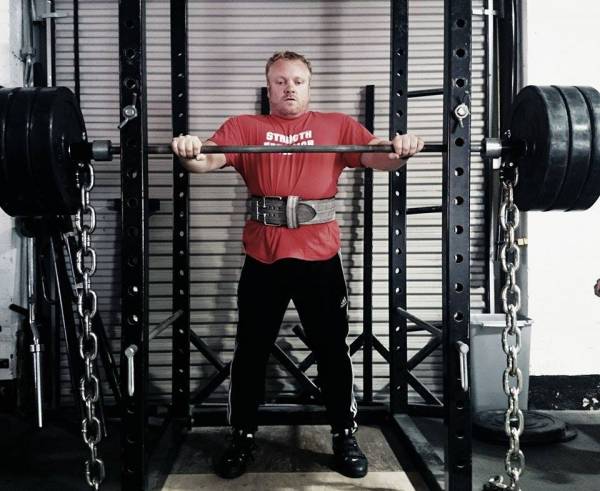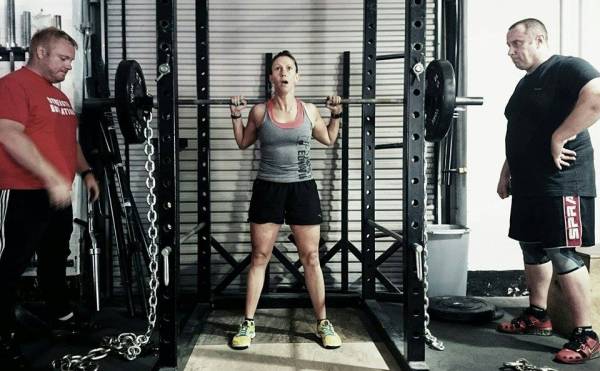The use of belts is a topic that is much considered, much debated, and sometimes contradictory – and that’s just me. I have a lot to say when it comes to the use of belts, when we may or may not use them, and why. So when people come up and ask me whether they should wear a belt (this happens a lot), I feel the need to take a step back and explain some of the fundamental concepts behind weight belts.
Belts are part of a much larger topic about bracing and breathing, and this is a topic that is very close to my heart. This is where the discussion originates, so this is where we will start, with the help of some of our other coaches at Breaking Muscle.
Bracing and Breathing
Breathing – well, that’s simple right? Actually it is, but don’t assume you know it already. As strength and conditioning coach Traver H. Boehm says in his video Using Your Breath For Better Performance, “You might think you know how to breath, but it turns out many of us learned bad breathing habits early on in our strength training.” But that’s not the only reason to focus on your breathing. Traver continues, “Taking a deep breath can also prepare you mentally and physically for a challenging and/or explosive movement.”
So how do you breathe effectively? In fact, that’s not the first part of the puzzle. The first part is to brace the core. But how do you actually do that? I guarantee that there are coaches shouting “brace the core” up and down the country with clients who have little to no idea how to actually put it into action.
The easiest way of thinking about it is to imagine someone is about to punch you. As Olympic weightlifting coach Wil Fleming puts it in his article How to Brace and Breathe Properly for Weightlifting:
This cue brings about the image, or it should at least, of bracing your abdomen for a punch to the gut from Chuck Liddell. (There are probably more current references, but the Iceman packed a punch back in the day.)
This is a useful cue, but not much by way of explaination. I love the way Wil goes on to explain it:
Bracing is simply the best way to engage the entirety of the core and to create stiffness in an area that normally does not have stiffness. Mike Robertson, coach at Indianapolis Fitness and Sports Training, defined the function of the core in the simplest way that I have heard, when he talked about “the two Rs” of the core.
The core has two functions: The first is redistribution, as in redistribution of tension. Think of this R like a suspension bridge. The cables themselves are not tight to begin with, but they can support the weight of the bridge below through a redistribution of tension, like in a plank. The second R is redirection, as in the redirection of force. Power that is created in the lower body can only be moved along the kinetic chain through a core that is tight.
Where Belts Fit In
So where do belts fit into all of this? When you brace and breathe in the above manner, you are basically creating your own weightlifting belt. As Traver explains:
In reality, your breath should be your natural “weight belt” creating core stability during your weight bearing movements. Weight bearing movements include everything from barbell and dumbbell exercises to bodyweight exercises like push-ups.
The foundation of this idea of core-stability is the concept of intra-abdominal pressure. Olympic weightlifting coach Nick Horton discusses this in more detail in his article Weightlifting Belts: Should You Use One? Pro and Con:
All of the upsides to wearing a belt come down to the idea of intra-abdominal force or pressure. A study done by Miyamoto, et al. found that “Intra-muscular pressure of the erector spinae muscles increased significantly by wearing the abdominal belt during Valsalva maneuvers and during maximum isometric lifting exertions”. In short, if you increase the pressure in the abdomen, then you better stabilize the whole area which makes for a safer environment for the spine and can increase your ability to lift heavier weights.

A general rule of thumb is to start wearing a belt around 80-85% of your max. It’s useful to have that number in mind to know if you are way off the mark, but for me, it’s better to go my feel. In my article 5 Mistakes You Might Be Making With Your Weightlifting Belt, I wrote
When the going gets tough, the tough wear a belt. I’m not suggesting you wear a belt for all your warm-ups sets. But when it starts to get hairy, add the belt. In fact, I would advocate wearing the belt prior to the sets that matter. Breathing hard against the belt is a skill that needs to be practiced, especially when performing continuous repetitions.
Lifting Raw
If belts are so good, why not wear your belt all the time? This brings us to the topic of lifting raw. Robert Camacho opens up this topic well through his article Getting the Most Out of Assistive Gear: A Motor Patterning Perspective:
Assistive gear is not intended to solve, improve, or bypass a biomechanical problem. If you are lacking strength, then you need to build strength, not wear a belt.
As you’ve probably worked out by now, I’m a big advocate of using a belt. Does that mean I don’t believe in lifting raw? Absolutely not. Are you confused yet? Figured as much. Let’s take a look at the topic of lifting raw. As we’ve already seen there is a bracing and breathing sequence that needs to be followed. This needs to be learned. Nick Horton explains how belt wear can mess with this motor learning.
Many of the best exercises in the gym require a correct pattern of recruitment of the abdominals (including the obliques and transverse abdominals). With beginners, weight belts circumvent their learning of how to “squeeze” their abs tightly and in the right ways during a heavy lift. The belt just takes over.
He continues to state a clear but important consideration:
This issue, however, is pretty easy to get around if you have a good coach or you are paying attention. You should never use a belt in place of proper core work, stabilization, and technical learning. But that should be obvious.
As far as I am concerned, a coach should spend time teaching clients how to breathe properly and effectively without the use of the belt. If this coaching is done correctly, it will transfer well, and almost immediately, into the effective use of a belt. However I still believe that getting the most out of a belt is a skill that needs to be learned and practiced.

Psychological Effects of Belts
I think a lot of it is that they think the belt will protect their back so not as much attention is paid to form. It may also give them a false confidence and encourage them to lift a larger weight than they are truly capable of.
Summary
To summarize, don’t shy away from belts. Learn how to brace and breathe properly first and then learn how to use a belt properly. Train raw often, and always start your workouts like this before adding a belt when it gets heavy. Educate and familiarize yourself with the dos and don’ts of belt use and act accordingly. Enjoy getting stronger!
Photos courtesy of Strength Education.






